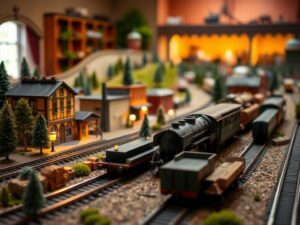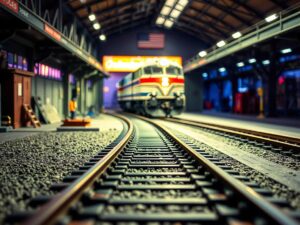Common Problems with HO Scale Trains and How to Fix Them
Common Problems with HO Scale Trains and How to Fix Them
Common Problems with HO Scale Trains and How to Fix Them
Welcome back to the exciting world of model railroading! As an enthusiastic hobbyist myself, I’m always eager to share my knowledge and help fellow rail fans navigate the intricacies of this beloved pastime. Today, we’re diving into a topic that often pops up among both newbies and seasoned veterans: common HO scale train problems.
HO scale, with its detailed miniature world and accessible size, is a fantastic way to bring your imagination to life. But like any intricate hobby, things can sometimes go awry. Fortunately, most common HO scale train problems are solvable with a bit of troubleshooting and some know-how.
Let’s equip you with the tools and knowledge to overcome these challenges and keep your miniature trains chugging smoothly along!
1. The All Too Familiar “Wheels Won’t Turn” Mystery:
Nothing is more frustrating than watching your shiny locomotive stand stock still, refusing to roll even on the smoothest track. This problem can arise due to a few culprits:
-
Dusty Tracks: A thin layer of grime and dust can accumulate on tracks over time, creating friction that hinders smooth movement.
Solution: Use a soft cloth or cotton swabs moistened with isopropyl alcohol to gently clean the rails. You can also find specialized track cleaning cars designed to scrub away dirt and debris while your train is in motion.
-
Loose Wheels: Sometimes wheels detach from their axles due to wear, vibrations, or even being mishandled.
Solution: Examine your wheels carefully. If a wheel seems loose, you can often gently push it back into place using a small screwdriver or a pair of needle-nose pliers. Be extremely careful not to damage the axle or surrounding components.
-
Track Alignment Issues: Even tiny deviations in track alignment can cause major resistance for your train. This is particularly true if there are any bends, curves, or elevated sections.
Solution: Carefully check for dips or kinks in your tracks and make adjustments with a pair of pliers or specialized track adjustment tools.
-
Tightly-Fitted Trucks: Trucks (the parts that hold the wheels) can become misaligned or overtightened, creating excessive friction.
Solution: Carefully loosen the screws that secure the trucks to the locomotive frame using a small screwdriver. Once slightly loose, test your train for movement. Adjust tightness until you achieve smooth rolling with minimal effort.
2. Electrical Ebb and Flow: Power Problems:
Whether your train suddenly stalls mid-run or simply refuses to come to life, electrical issues can be perplexing.
-
Loose Connections: Over time, wires connecting the track to the power supply, and the locomotive to its wheels can become loose or corroded, disrupting the flow of electricity.
Solution: Check all wire connections at both ends and ensure they are firmly attached and clean. A small amount of solder can be helpful for secure connections. Consider using a multimeter to test for voltage across key points in your wiring setup.
-
Power Source Issues: The power source itself might be faulty.
Solution: Make sure your power supply is working properly by testing it with other devices. Check for loose or frayed cords. If you are using batteries, ensure they have sufficient charge and are the correct type.
3. Lighting Glitches: Dim Beacons in Your Model World:
-
Burned Out LEDs: LED lights can eventually burn out just like any other electrical component.
Solution: Inspect your locomotive’s lighting components and carefully replace any burned-out LEDs with new ones of the same specifications. Remember to exercise caution when handling delicate electronic components.
-
Connection Issues: Faulty wiring connections between the light fixtures and the power source can cause flickering or dimming.
Solution: Check all connections associated with your lights, ensuring they are secure and clean. Carefully test each light separately using a multimeter to isolate potential problem areas.
Troubleshooting Tips for HO Scale Train Problems:
- Methodical Inspection: Don’t rush the process! When troubleshooting, systematically check each component â the track, locomotive, wiring, wheels â for visible signs of damage, debris, or loose connections.
- Read the Manuals: Manufacturer manuals often provide valuable insights into common issues and solutions specific to your model train set. They can be a gold mine of information.
-
Join Online Communities: Connect with fellow hobbyists online! There are numerous forums and groups dedicated to HO scale modeling, where you can share your experiences, seek advice, and learn from others who’ve tackled similar challenges.
-
Donât Give Up!: Model railroading is a rewarding but occasionally challenging hobby. Be patient, persistent, and remember that every seasoned enthusiast started as a beginner once!
With these tips in hand and the knowledge gained from tackling common HO scale train problems, you’ll be well on your way to building an incredible miniature world and experiencing the endless joy of this fascinating hobby!




